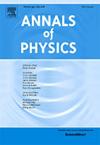Investigating quantum criticality through charged scalar fields near the BTZ black hole horizon
IF 3
3区 物理与天体物理
Q2 PHYSICS, MULTIDISCIPLINARY
引用次数: 0
Abstract
We examine a charged scalar field with a position-dependent mass , where represents a Lorentz scalar potential, near a BTZ black hole in the presence of an external magnetic field. By deriving the Klein–Gordon equation for this setup, we explore two scenarios: (i) a mass-modified scalar field with (an exactly solvable case), and (ii) a scenario involving both mass modification and an external magnetic field (conditionally exactly solvable). We identify quantum critical points (QCPs) associated with the coupling constant . In the first scenario, for massless charged scalar fields, critical points occur at for all radial quantum numbers and magnetic quantum numbers . In the second scenario, these critical points shift to for and , with the case excluded. For massive scalar fields, QCPs emerge at , leading to non-propagating fields at zero frequency. At these QCPs, the field frequencies drop to zero, marking transitions from stable oscillatory modes to non-propagating states. Below the critical points, the system exhibits instability, characterized by negative imaginary frequencies that suggest rapid decay and high dissipation. Above the critical points, the modes stabilize and propagate, indicating a transition to a superconducting-like phase, where dissipation vanishes and stable excitations dominate.
通过BTZ黑洞视界附近的带电标量场研究量子临界性
我们研究了一个带电标量场,其位置依赖质量m(ρ)=m0+S(ρ),其中S(ρ)表示在存在外部磁场的BTZ黑洞附近的洛伦兹标量势。通过推导此设置的Klein-Gordon方程,我们探索了两种情况:(i) m(ρ)=m0 - a/ρ的质量修正标量场(一种精确可解的情况),以及(ii)涉及质量修正和外部磁场的情况(条件精确可解)。我们确定了与耦合常数a相关的量子临界点(QCPs)。在第一种情况下,对于无质量带电标量场,对于所有径向量子数n≥0和磁量子数|m|≥0,临界点出现在a=n+1/2处。在第二种情况下,当n≥0和|m|>;0时,这些临界点移到a=n+3/2,排除了m=0的情况。对于大规模标量场,qcp以a=(n+1/2)/2出现,导致零频率的非传播场。在这些qcp中,场频率降至零,标志着从稳定振荡模式到非传播状态的转变。在临界点以下,系统表现出不稳定性,其特征是负虚频率,表明快速衰减和高耗散。在临界点以上,模式稳定并传播,表明过渡到超导相,其中耗散消失,稳定激励占主导地位。
本文章由计算机程序翻译,如有差异,请以英文原文为准。
求助全文
约1分钟内获得全文
求助全文
来源期刊

Annals of Physics
物理-物理:综合
CiteScore
5.30
自引率
3.30%
发文量
211
审稿时长
47 days
期刊介绍:
Annals of Physics presents original work in all areas of basic theoretic physics research. Ideas are developed and fully explored, and thorough treatment is given to first principles and ultimate applications. Annals of Physics emphasizes clarity and intelligibility in the articles it publishes, thus making them as accessible as possible. Readers familiar with recent developments in the field are provided with sufficient detail and background to follow the arguments and understand their significance.
The Editors of the journal cover all fields of theoretical physics. Articles published in the journal are typically longer than 20 pages.
 求助内容:
求助内容: 应助结果提醒方式:
应助结果提醒方式:


